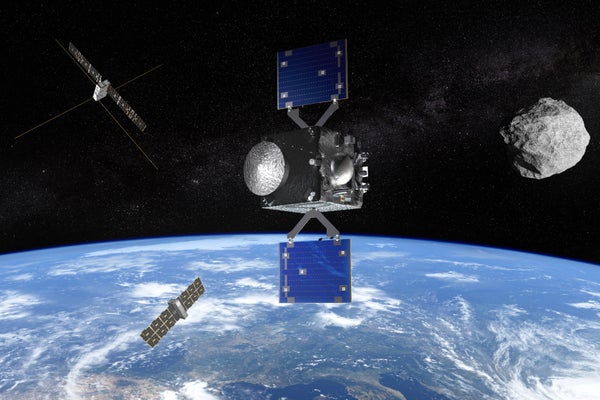Europe Announces New Mission to Infamous Asteroid Apophis
ESA’s Ramses spacecraft will scout out Apophis before and after the asteroid’s super-close flyby of Earth in 2029
Artist’s impression of ESA’s Rapid Apophis Mission for Space Safety.
Asteroid Apophis is ready for its close-up—but are we? In 2029 the sizeable space rock will swing by our planet within one tenth of the Earth-moon distance. Scientists and engineers are now racing against the clock to ready a spacecraft rendezvous to watch the rare encounter firsthand.
The project, dubbed the Rapid Apophis Mission for Space Safety, or Ramses, comes from the European Space Agency (ESA). Ramses must launch by April 2028—an ambitious timeline, especially because ESA budgeting quirks mean that Ramses isn’t yet fully funded, according to a July 16 ESA statement announcing the mission. But the opportunity is correspondingly historic: Ramses would arrive at Apophis in February 2029, about two months before the asteroid whizzes past Earth in a cosmic close shave that scientists estimate happens just once every 7,500 years or so for objects of this size—nearly as wide as the Empire State Building is tall.
“This will be the first time in the course of modern human history and human civilization where an object this large has gotten this close,” says Dani DellaGiustina, a planetary scientist at the University of Arizona, who is leading a separate NASA mission set to arrive later at Apophis. During the close encounter, Earth’s gravity is expected to change the asteroid in small—and potentially large—ways. Apophis will veer into a slightly different orbit around the sun, its circa 30-hour day could shorten or lengthen, and landslides and temblors may reshape its surface.
On supporting science journalism
If you’re enjoying this article, consider supporting our award-winning journalism by subscribing. By purchasing a subscription you are helping to ensure the future of impactful stories about the discoveries and ideas shaping our world today.
Scientists began sweating about Apophis shortly after its detection in 2004, when they realized the space rock’s orbit placed it on a possible collision course with Earth in 2029. Since then, careful study of the asteroid’s path around the sun has shown that not only is the 2029 flyby harmless but Earth is safe from Apophis for the foreseeable future.
That is very good news—at an estimated 1,100 feet (335 meters) across, Apophis would cause serious damage if it ever did hit our planet. The most recent notable asteroid to strike Earth exploded in the skies over Chelyabinsk, Russia in 2013, releasing energy equivalent to about 440 kilotons of TNT and injuring more than 1,600 people. Scientists have estimated that that asteroid was a mere 17 to 20 meters wide. An earlier impact in 1908, now known as the Tunguska event, saw the explosion from a 40-meter-wide asteroid knock down some 80 million trees across more than 2,000 square kilometers of remote Siberia.
Although scientists can now safely scratch Apophis off the list of apocalyptic threats currently facing humans, they aren’t yet confident that every other asteroid in Earth’s neighborhood is equally harmless. So scientists with planetary defense in mind are eager to use the Apophis flyby in 2029 as a once-in-millennia chance to learn about the space rocks that make such close encounters.
“It’s an incredibly rare event that an asteroid like Apophis would hit the Earth, but it’s better to be knowledgeable than to caught unaware,” says Richard Binzel, a planetary scientist at the Massachusetts Institute of Technology, who has spent years raising awareness about the scientific opportunities of the 2029 flyby.
NASA has already retasked the OSIRIS-REx mission to spend two years orbiting Apophis, but the spacecraft won’t get there until shortly after the close encounter. It has a good excuse for tardiness—that was the soonest it could arrive after completing its primary mission last fall, the delivery of precious material from an asteroid called Bennu to Earth. (The mission, now dubbed OSIRIS-APEX, is led by DellaGiustina.)
DellaGiustina and her colleagues are confident that they can use the mission’s data to reconstruct how the close pass with Earth affected Apophis. But a mission like Ramses, which is targeting a six-month stay at Apophis beginning two months before the encounter with Earth, could offer priceless observations of the asteroid’s pre-flyby state. Ramses may even provide a whole-asteroid view of Apophis responding to the tug of Earth’s gravity, says Paolo Martino, an engineer at ESA leading the Ramses project. The agency also hopes to equip the spacecraft with a smaller, deployable companion that could touch down on Apophis before the encounter for a firsthand, ground-truth report.
Of course, that requires ESA to meet a tight schedule by sprinting to build, test and launch an ambitious interplanetary mission in less than four years. It’s possible only because the Ramses spacecraft will be essentially a twin of ESA’s Hera mission, with only small tweaks to its solar panels and fuel tanks, Martino says. Hera is due to lift off this autumn to survey Didymos and Dimorphos, the binary asteroid NASA hit with its Double Asteroid Redirection Test (DART) mission in 2022.
The two missions are related by more than just spacecraft design. The DART mission tested whether humans could nudge an asteroid in its orbit to avoid a collision with Earth, should the need arise—a key tenet of planetary defense. Ramses will test a separate aspect of the field: whether humans, should they discover an asteroid on track to hit Earth, can launch a spacecraft to scout out a target quickly enough to shape an intervention mission. And the observations that Ramses and OSIRIS-APEX gather should also help scientists understand the structure of space rocks across the solar system—crucial information for any apocalypse-averting future mission.

